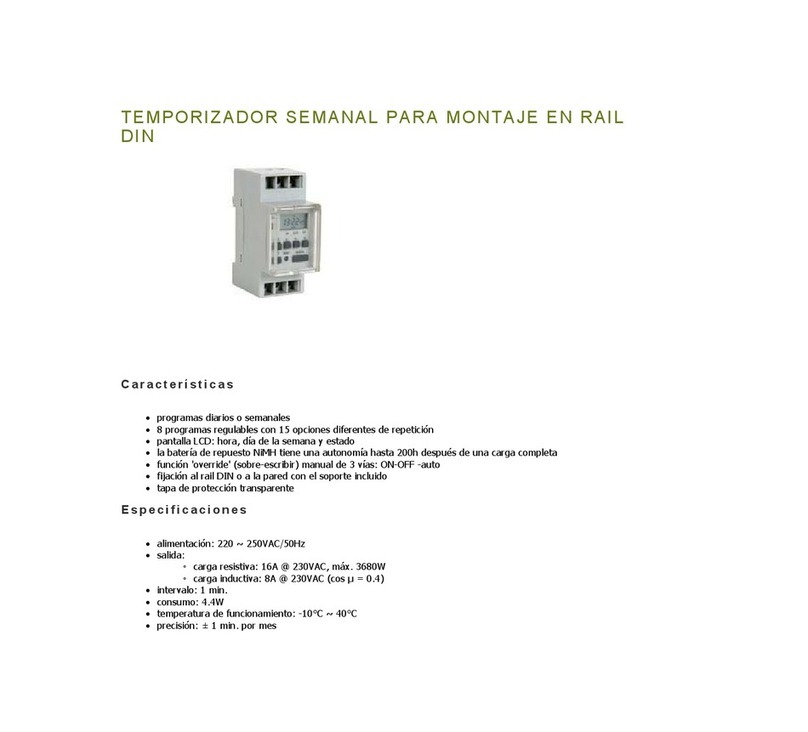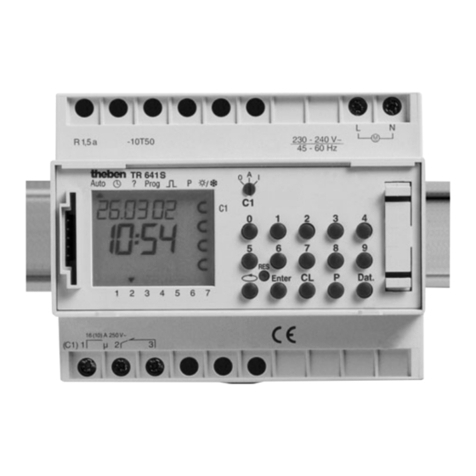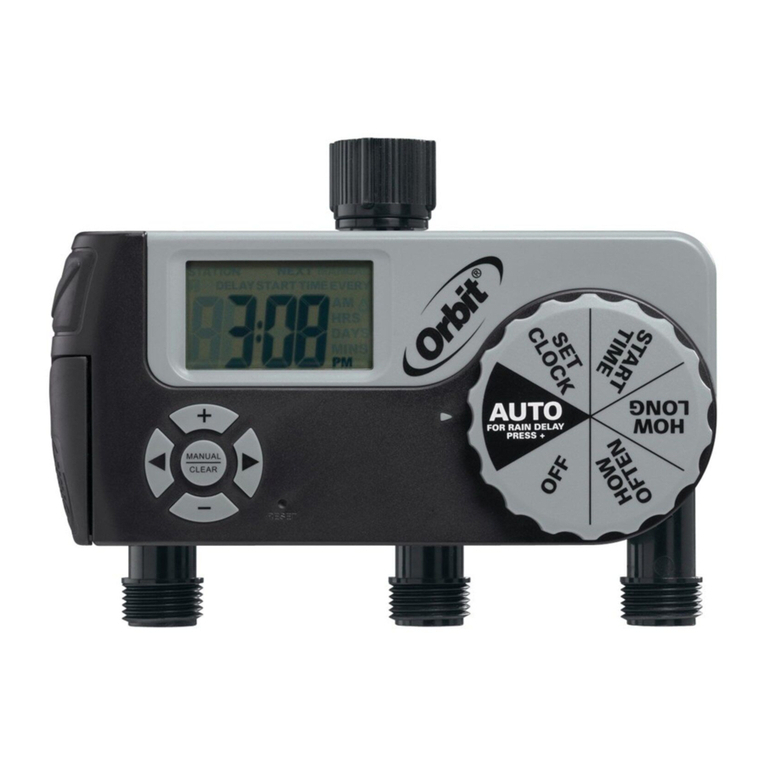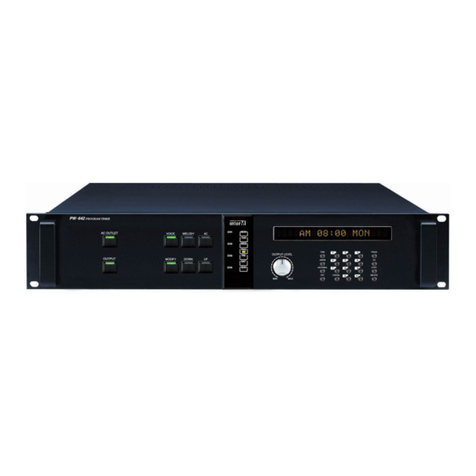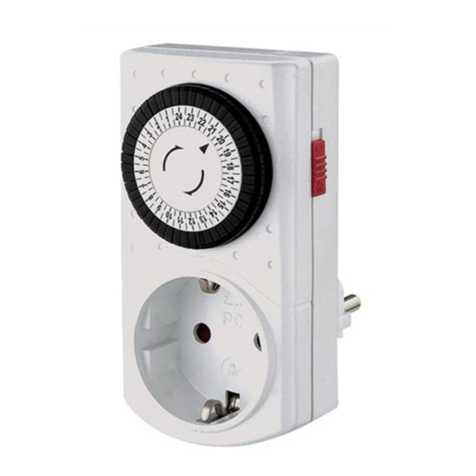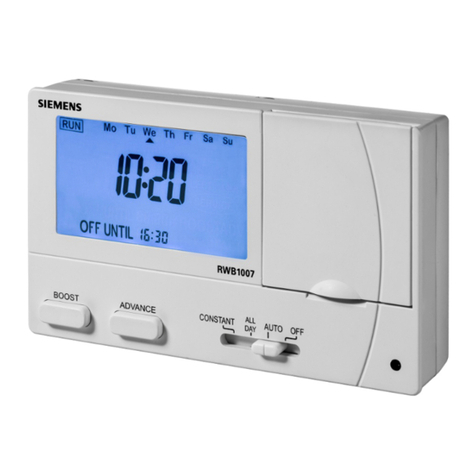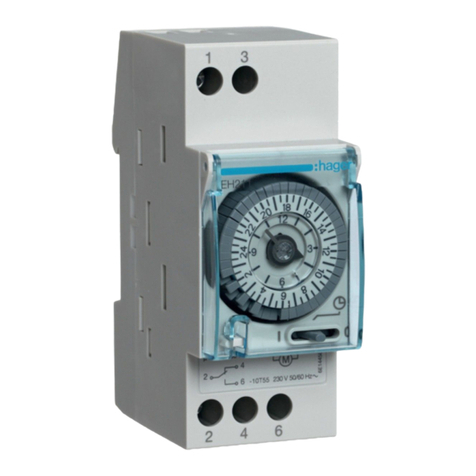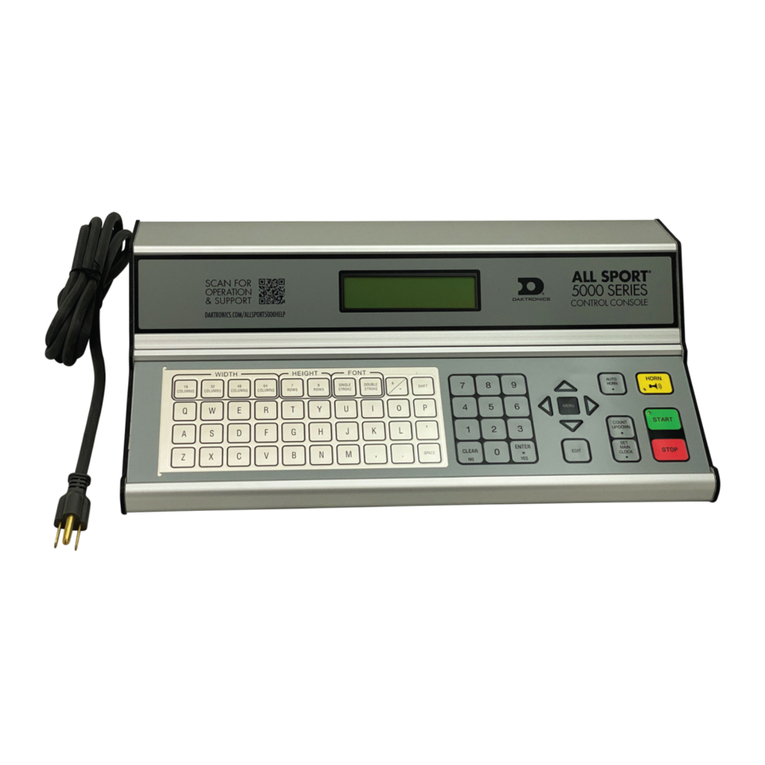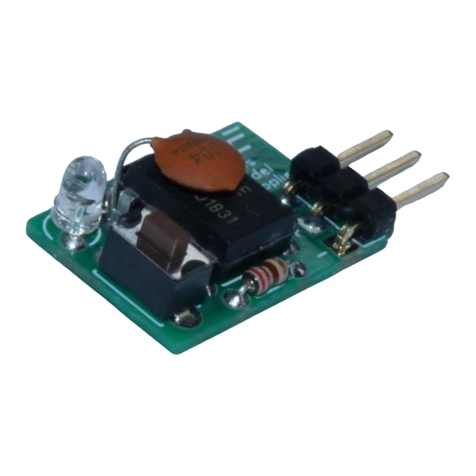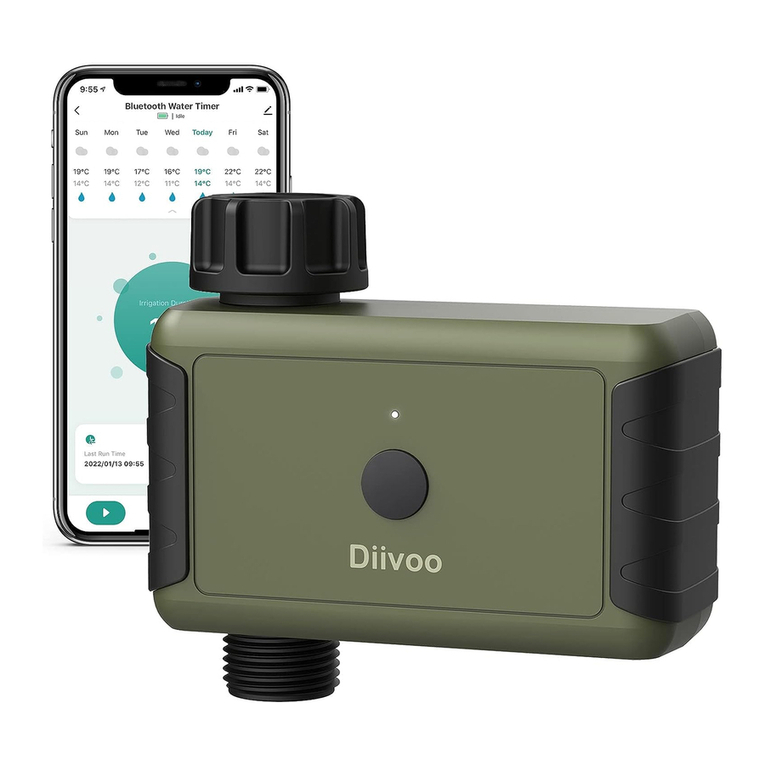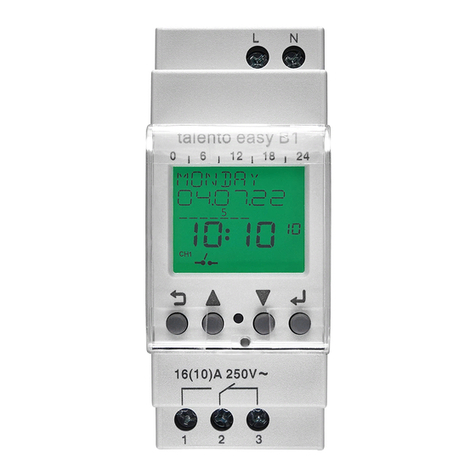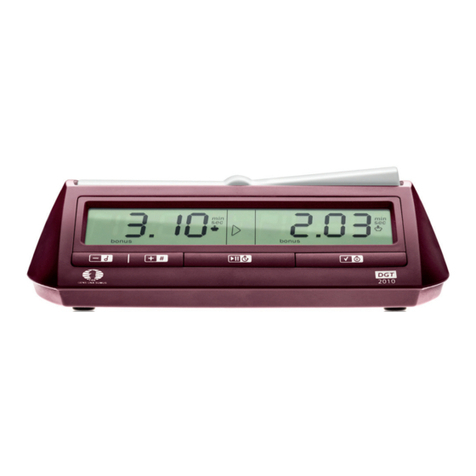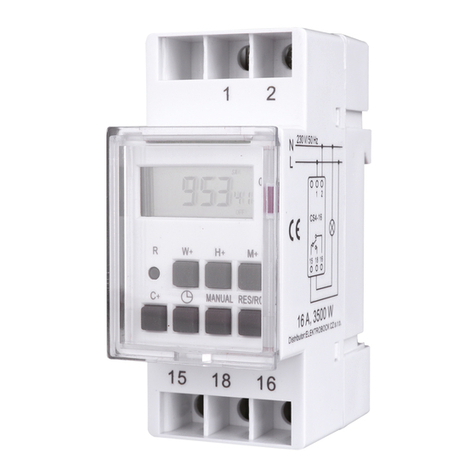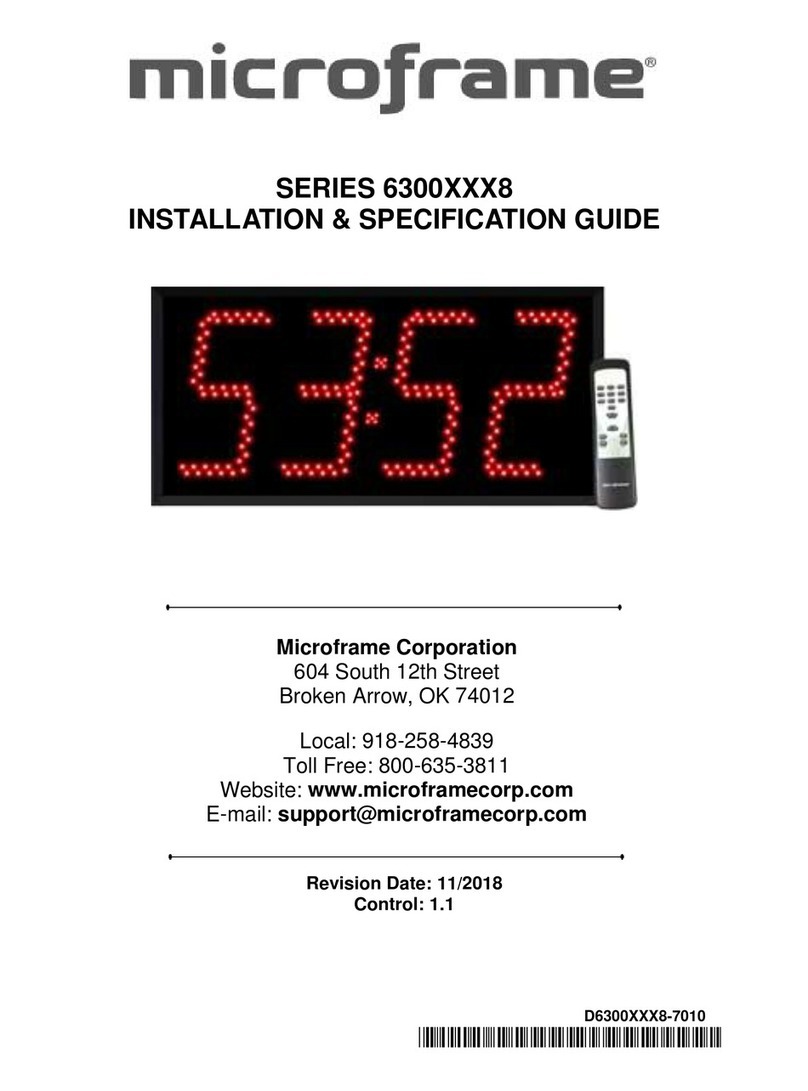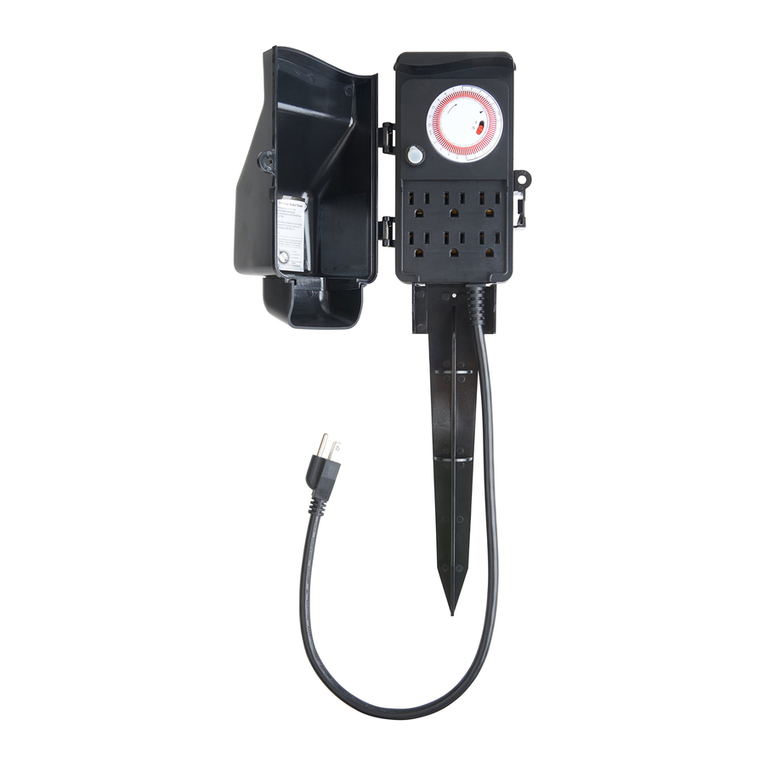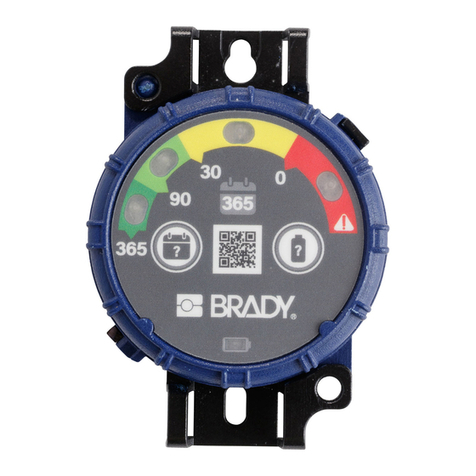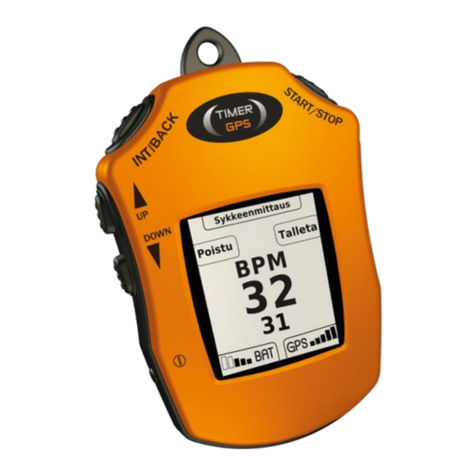PRELIS CHRONOSKOP CHR-9 User manual

CHRONOSKOP CHR-9
Digital watch timing machine
Instruction Manual
© 2017 www.CHRONOSKOP.com
ENGLISH


Chronoskop CHR-9 Timegrapher User manual www.CHRONOSKOP.com
3
Table of Contents
1. INTRODUCTION.......................................................................................................................... 5
1.1. GENERAL INFORMATION ON THE DEVICE FUNCTION................................................................ 5
1.2. CONNECTION LINES ..................................................................................................................... 7
1.3. TOUCHDISPLAY............................................................................................................................ 8
1.1. COMMISSIONING.......................................................................................................................... 8
1.2. BATTERY MODE............................................................................................................................ 8
2. THEORETIC BASICS.................................................................................................................. 9
2.1. SCHLAGZAHL /GANG /PERIODENDAUER .................................................................................. 9
2.2. ABFALLFEHLER (REPÈRE) .......................................................................................................... 9
2.3. AMPLITUDE ................................................................................................................................ 10
3. MEASUREMENT WITH THE TIMEGRAPHER .................................................................. 11
3.1. AKUSTISCHE MESSUNG ............................................................................................................. 11
3.2. OPTICAL LIGHT BARRIER MEASUREMENT .............................................................................. 13
3.3. VERWENDUNG DES KOPFHÖRERANSCHLUSSES ...................ERROR!BOOKMARK NOT DEFINED.
3.4. MESSUNG MIT EXTERNEN SENSOREN...................................ERROR!BOOKMARK NOT DEFINED.
3.5. MENUEAUFBAU .......................................................................................................................... 14
3.6. START DER MESSUNG UND DIE SCHALTFLÄCHEN ...............ERROR!BOOKMARK NOT DEFINED.
3.7. MESSUNG –AUSGABE DER ZAHLENWERTE ............................................................................. 16
3.8. MEASUREMENT –DIAGRAM VIEW............................................................................................ 17
3.9. MESSUNG -DIE ZEITACHSENDARSTELLUNG ........................................................................... 19
3.10. MESSUNG -DIE IMPULSDARSTELLUNG .................................................................................. 20
3.11. OPTISCHE ZEIGERMESSUNG ...............................................ERROR!BOOKMARK NOT DEFINED.
4. EINSTELLUNGEN...................................................... ERROR! BOOKMARK NOT DEFINED.
4.1. AUSWAHL DER MENÜSPRACHE................................................................................................. 22
4.2. AUSWAHL DER MESSQUELLE.................................................................................................... 22
4.3. EINSTELLUNG DER SCHLAGZAHL............................................................................................. 23
4.4. ZEITINTEGRATION..................................................................................................................... 24
4.5. EINSTELLUNG DES HEBEWINKELS........................................ERROR!BOOKMARK NOT DEFINED.
4.6. DISPLAYBELEUCHTUNG.........................................................ERROR!BOOKMARK NOT DEFINED.
4.7. QUARZFREQUENZEINSTELLUNG...........................................ERROR!BOOKMARK NOT DEFINED.
4.8. DER QUARZOFEN ....................................................................................................................... 25
5. CALIBRATING THE QUARTZ FREQUENCY..................................................................... 26
5.1. ABOUT THE CALIBRATING WITH DCF77 RADIO SIGNAL......................................................... 26

Chronoskop CHR-9 Timegrapher User manual www.CHRONOSKOP.com
4
5.2. CALIBRATING THE TIMEGRAPHER........................................................................................... 27
6. OUTPUT OF INFORMATION.................................................................................................. 28
6.1. DEVICE INFORMATION............................................................................................................... 28
6.2. LAST MEASUREMENT DATA....................................................................................................... 28
7. PC-SOFTWARE „CHRONOPORT 2.0“.................................................................................. 29
7.1. GENERAL FUNCTIONS ................................................................................................................ 29
7.2. SYSTEM REQUIREMENTS ........................................................................................................... 29
7.3. CONNECT THE TIMEGRAPHER.................................................................................................. 29
7.4. INSTALLATION OF THE SOFTWARE........................................................................................... 30
7.5. DIRECT START OF THE APPLICATION....................................................................................... 33
7.6. WINDOW STRUCTURE ................................................................................................................ 33
7.7. MENU STRUCTURE ..................................................................................................................... 34
7.8. MEASUREMENT.......................................................................................................................... 35
7.9. SAVE AND OPEN MEASURE PROTOCOLS................................................................................... 35
7.10. PRINTED MEASUREMENT PROTOCOL .................................................................................... 36
7.1. DEINSTALLATION....................................................................................................................... 36

Chronoskop CHR-9 Timegrapher User manual www.CHRONOSKOP.com
5
1. Introduction
1.1. General information on the device function
The Chronoskop CHR-9 timegrapher is an electronic measuring and testing device for the
production, repair and service of mechanical watches. The Timegrapher allows as well an
acoustic as a light barrier measurement with an external light barrier. Values such as Rate,
Beat Number, Beat Error and the average duration of a half-wave can be determined. With
sufficient quality of the acoustic signal, the amplitude of the clock can be measured. In a
long-term measurement, the temporal behavior of the rate can be observed on a graph. The
measurement results are displayed as graphically and as numerical values on the illuminated
touch display. During the measurement, you can switch between different display modes.
The target rate can be determined automatically, selected manually or individually set and
saved.
The acoustic measurement is realized with the built-in or an external piezo microphone. To
decouple acoustic noise, the built-in piezo is mounted on a 5 mm thick foam. The signal gain
can be adjusted with the rotary knob in the front wall. To measure a watch or a small clock, it
is to be placed on the piezo disk of the built-in microphone.

Chronoskop CHR-9 Timegrapher User manual www.CHRONOSKOP.com
6
The optical measurement with the light barrier is used to measure pendulum clocks.
The multilingual menu navigation in English, German, Spanish, French, Italian and Polish
guides you easily and clearly through the functions.
The Timegrapher can be calibrated with an optional DCF77 radio receiver. The radio signal
of the atomic clock in Mainflingen (DCF77) is used as a reference signal for calibration. This
calibration method allows a measurement accuracy of a few seconds per year. In order to
ensure the highest stability of the quartz frequency and thus also the measuring accuracy,
the built-in quartz oscillator is heated in a quartz oven and kept at a constant temperature.
Thanks to the built-in headphone jack, you can directly listen to the clock work. The device
also has an external microphone input, an interface for external sensors and active
microphones, a microphone sensitivity control, a contrast adjustment knob and a touchpen
slot.
The measurement results can be sent via a USB interface to a PC, where they can be saved
or printed with the software Chronoport 2.0. All data is constantly sent to the computer and
displayed there as numerical values and graphics. Direct data transmission allows the entire
measurement to be displayed in a movable endless graphic. You can switch the operating
language between the languages English, German and Polish. The measured data are
stored together with the graphic. An summary of the measurement is printed on a DIN A4
sheet. The software can be installed on the computer, but can also be started from the disk.
System requirements: MS Windows from version Windows 98. The software is available as
download on our website. Of course the device works also without a PC.
The use of the latest microcontroller electronics realized with modern SMD technology allows
a compact solution (about 9cm x 9cm x 4cm) that gives the device manageability, it is easy
to transport and can be used in battery mode in many places. For further actual information,
please refer to the user manual, which you can download from our website.

Chronoskop CHR-9 Timegrapher User manual www.CHRONOSKOP.com
7
1.2. Connection lines
The device includes the following lines and idicators:
Die Frontseite
Fron side
Rear side
LED Green - Signal of a piezo microphone
LED Yellow - Signal of the radio reciver or heating
LED Red - Error or incorrect signal during the measuring or calibrating
Headphone port
Microphone sensitivity adjustment
Analog
microphone port
External digital sensor port
(e.g. DCF77, external lightbarrier sensor)
Touchpen input
(POWER ON/OFF)
Display contrast adjust
IR sensor for the light barrier
IR LED for the light barrier
Power
supply
USB Interface
Serial Interface
(disabled by default)

Chronoskop CHR-9 Timegrapher User manual www.CHRONOSKOP.com
8
1.3. Touchdisplay
The device has a touch display. It should not be confused with greater force than the weight
of 100g: Fracture risk! To operate the timegrapher use the included touch pen. Do not use
sharp metal objects. You can also use your fingernail or a blunt tip of a plastic pen. Fields
with a given touch function in the moment, are always described on display with bright
lettering on a dark background.
1.1. Commissioning
For power supply use only the power supply included in the
package or our battery pack. Commissioning of the unit should
be considered in the ambient temperature in which the
instrument has been calibrated (see chapter "calibration"). The
timegrapher turns on by pullig the touch pen from the housing.
To turn it off insert the touch pen back into the housing.
1.2. Battery mode
The device is equipped with a battery case, which is located on the lower side of the device.
In battery mode, the Timegrapher is operated with a 9 V block. In order to increase the
battery life, the display illumination can be switched off in the settings. It may happen that
when the battery power drops, the display contrast must be readjusted when switching to
battery operation.
OFF
ON

Chronoskop CHR-9 Timegrapher User manual www.CHRONOSKOP.com
9
2. Theoretic basics
2.1. Beats / Rate / Period Time
To calculate the rate deviation (R), the measured period is compared with the set or
determined reference value. The period or half-cycle duration is the average time between
beats.
Period duration is calculated as follows: TP= ( TTIC + TTAC ) / 2
The number of beats per hour is called the Beat Number (BR).
2.2. Beat error
If the balance oscillates asymmetrically around the zero position, the period duration of
consecutive beats TTAC and TTIC is unequal. The beat error is calculated from the difference
between the half-wave durations and given in miliseconds.
Beat error is calculated as follows: TP= ( TTAC –TTIC ) / 2

Chronoskop CHR-9 Timegrapher User manual www.CHRONOSKOP.com
10
2.3. Amplitude
The amplitude is the maximum amplitude of the balance and is given as an angle to the
equilibrium position. The amplitude values of the wristwatches are around 260 ° - 310 °.
To determine the amplitude, the impact sound must be examined more closely. A beating
noise of the Swiss lever escapement consists of three impulses:
1. Impuls: The lever of the roller hits the fork of the anchor.
2. Impuls: A tooth of the escape wheel hits the impulse surface of a pallet and the
anchor fork touches the lever stone.
3. Impuls: The strongest noise. A tooth of the escape wheel falls on the resting surface
of the pallet and the anchor rod strikes a limit pin.
Based on the known lift angle λ(mostly 50°- 52°) and the measured lifting time of the
balance TH(time interval between the first (1) and the third (3) impulse), the amplitude Ais
determined.

Chronoskop CHR-9 Timegrapher User manual www.CHRONOSKOP.com
11
3. Measurement with the Timegrapher
There are two ways to measure mechanical clocks using the time scale. There are:
•Acoustic measurement
•Measurement with the light barrier
During acoustic measurement the sound of the clock is detected. In the light barrier
measurement the light path of the pendulum is interrupted. The source of the measurement
(acoustic or optical) is to be set in the settings of the device.
3.1. Acoustic Measurement
Measurement with the built-in piezo microphone
The acoustic measurement can be realized with the built-in piezo microphone. To decouple
acoustic noise, the piezo disk is mounted on a 5 mm thick foam. For maximum decoupling
the device can be placed on an additional foam. Because of the high sensitivity of the
microphone (despite digital filtering), ambient noise should be avoided. The signal gain can
be adjusted with the rotary knob placed in the front wall of the device. For very quiet watches
it is recommended to remove the back cover of the watch for the duration of the
measurement. The use of the battery voltage can also help to avoid the noise from the
voltage network.
To measure a wristwatch or a small watch, place it on the microphone on the top of the
device. In order to optimally transfer the vibrations to the piezo crystal, the watch case should
lie directly on the microphone. This method is only allowed for watches up to 200 g! Although
the covering metal disk of the piezo element of the microphone is made of a soft metal, the
watch should be placed with care to avoid scratches.
Please note: Piezo discs are very sensitive. When measuring with the built-in microphone
you should even avoid the use of the display during the measurement, as this can generate
noise too.

Chronoskop CHR-9 Timegrapher User manual www.CHRONOSKOP.com
12
Measurement with the external acoustic crocodile microphone
The external crocodile microphone belongs to the optional accessories and can be ordered
separately.
For acoustic measurement, an external piezo microphone from the optional accessories can
be used. This is to be connected to the 3.5 mm microphone jack. When plugging in the
microphone plug, the built-in microphone is automatically deactivated. The crocodile
microphone is to be clamped to the watch case. It is particularly suitable for measuring
mechanisms of large clocks. For acoustic measurements of clocks with percussion the
percussion should be switched off to avoid noise. Microphones connected to the external
power supply are not allowed to be used.
The crocodile microphone gives a lot of flexibility and is very useful when measuring a clock
in different positions. It is characterized by very good decoupling from the ambient
noise.
External crocodile microphone
Adjustment of microphone sensitivity
The "Sensitivity" rotary knob allows you to adjust the sensitivity of the piezo microphone. It
should be noted that neither minimum nor maximum microphone sensitivity leads to optimum
signal processing. The best result is usually achieved approximately in the middle position of
the rotation. The sensitivity should be set until every single measuring pulse is clearly
recognizable in the "Time axis" display mode. Noisy noise (such as fan noise in the PC)
should be avoided. This noise is not visible in the time scale display, but reduces the
sensitivity of the amplifier electronics significantly.

Chronoskop CHR-9 Timegrapher User manual www.CHRONOSKOP.com
13
3.2. Optical Light Barrier measurement
Optical measurement is based on the principle of the light barrier. If the clock pendulum or
the minute hand interrupts or reflects the light beam of the transmitter diode, the receiver
diode of the time scale receives a pulse. Please note that the frequency of the infrared light
emitted by the diode is outside the visible range. Avoid strong extraneous light during the
measurement.
Light barrier measurement of the pendulum (internal light barrier)
Pendulum clocks can be measured with the optical light barrier. In order to measure the
clock with the built-in light barrier, the Timegrapher is to be placed with the outgoing infrared
LEDs and the supplied reflector toward the swinging pendulum, so that the pendulum
interrupts the invisible light beam (see picture bolow). If the invisible infrared beam of the
light barrier is interrupted, the Timegrapher registers an impulse. The reflector should be
aligned as possible directly opposite to the diodes, parallel to the rear wall of the housing. Do
not stick the reflector directly to the watch case. With a reflective pendulum you can even
work without the reflector.
Light barrier measurement of the pendulum (external light barrier)
When using the external light barrier place it so that the oscillating
pendulum passes through the light barrier between the two beveled
ends of the fiber optic columns.
Optical measurement of the minute hand (external Licht Barrier
Sensor)
The external light barrier also allows the measurement directly at the
minute hand. To do this, place the light barrier so that the pointer
passes through the light barrier during the hourly cycle.
The external light barrier is an optional accessory and can be ordered necessary.

Chronoskop CHR-9 Timegrapher User manual www.CHRONOSKOP.com
14
3.3. Using the headphone jack
The Timegrapher has a headphone jack for listening to the clockwork. The volume is
adjusted using the microphone sensitivity knob. Before plugging in the microphone plug, the
volume / sensitivity must be set to minimum. Place the watch on the piezo microphone and
slowly increase the volume. Keep the headphones as far away as possible from the piezo
microphone.
CAUTION: Setting the volume too high may cause hearing damage!
3.4. Measurement with external sensors
External sensors, such as radio receivers or active microphones, can be
connected to the built-in 4-pin Mini-DIN socket. Only devices from the
original accessories may be used. Please read the user manual
enclosed with the optional active microphone.
3.5. Menu structure
The following is an overview of the menu assembly:
Settings
Main Menu
Beat number setting
Save
the frequency
Measurment
Start
Calibration
of Oscillator
Last measure
Device informations
Language
Light (ON/OFF)
Source
Lift angle
Time integration (ON/OFF)
Quarz frequence
Heater (ON/OFF)

Chronoskop CHR-9 Timegrapher User manual www.CHRONOSKOP.com
15
3.6. Starting the measurement and the buttons
When starting a measurement from the main menu, you are automatically guided to the
measurement with numerical values view. After a periodic signal has been detected, the
actual measurement begins. If an error occurs during the measurement or if no periodical
signal has been detected (yet), the red lamp will light up. During the measurement it is
possible to switch between the display modes arbitrarily. The buttons serve:
Numerical values view
Diagram view
Long-Time behavior view
Impulse analysis view
Further buttons are:
Restart the measurement.
This deletes all measured values and restarts measurement.
Amplitude measurement: automatic / manual
You can choose between automatic or manual determination of the lifting time
of the balance TH(see Theoretical Basics), which is necessary for the calculation of the
amplitude. With manual amplitude measurement, you can limit the lifting time of the balance
by moving the brackets in the Impulse Analysis view.
Exit
Exits the measurement and returns to the main menu.

Chronoskop CHR-9 Timegrapher User manual www.CHRONOSKOP.com
16
3.7. Measurement –Numerical Values
Numerical values
R: Rate [mm:ss.f /24h]
BR: Measured Beat Number [/h] / Reference Beat Number [/h]
TP: Half period time of oscillation [ms]
T3: Lifting time of the balance
E: Beat error [ms]
A: Amplitude
Temperature of the oscillator
T: Timing progress / beats used for calculation
Icons
During the measurement in the lower right corner are displayed symbols (so-called icons),
which give some information about different states. They are:
Measure source: Acoustic measurement
Measure source: internal optic light barrier
EXT Measure source: external sensor
Signal processing
Long-term measurement
Interfering signal
Measurement with time integration
A pulse failed or Signal missing

Chronoskop CHR-9 Timegrapher User manual www.CHRONOSKOP.com
17
Horizontal bar of signal amplification
The horizontal bar shows the strength of the incoming signal. In the optimal case, the signal
strength should oscillate around the middle position. This can be adjusted with the sensitivity
dial. For the measurement of the amplitude the adjustment of the signal amplification is
decisive.
3.8. Measurement –Diagram view
When measuring in diagram view, the determined values are converted into a graphic curve
and shown on the display. The time between two successive clock beats (period duration) is
measured and compared with the setpoint value. If the measured time is exactly equal to the
set point, the new point on the graph will be placed next to the previous one - creating a
horizontal line. If, on the other hand, the new beat comes too early, the new point,
corresponding to the time difference from the setpoint, is shown slightly higher than the
previous one. Accordingly, a beat that arrives too late is set lower. The line of dots on the
display will therefore go up or down.
The diagram shows not only the rate deviation but also other temporal irregularities in the
clockwork, e.g. Waste error (Repère), defective escapement wheel teeth etc.

Chronoskop CHR-9 Timegrapher User manual www.CHRONOSKOP.com
18
Examples of clock behavior in The Diagram View
When measuring with a graphical view, the values are displayed on the right side of the
display. These are the same values, as in the measurement with the time axis.
The following part shows some examples of errors. These are the idealized representations
and should be used only for guidance. In reality usually several errors occur simultaneously.
Ideal clock Delay Clock is to fast
Light beat error Larger beat error Beat error with delay
Periodic error Noise Swing-into of a clock
Wrong beat number selected Selected beat number to small Selected beat number to big (2x)

Chronoskop CHR-9 Timegrapher User manual www.CHRONOSKOP.com
19
3.9. Measurement –Time axis view
Impulse view
In this mode the pulses are plotted on the one second time axis in the middle part of the
display (see picture). The smallest division of the axis corresponds to 50 ms, one pixel
corresponds to 10 ms.
If a signal is accepted for evaluation, it will be indicated with a dash.
Clock Rate graph in the long-term monitoring
The graph of the long-tern rate monitoring helps you to observe how the rateof the clock
behaves for a long time. Graphing will restart if any of the following occurs:
•Measurement is restarted
•A different Beat Numer is detected during the measurement with automatic beat
number recognition
•There is a strong disorder during the measurement
•The measurement is ended
The graph above the horizontal dotted zero line represents a positive rate, below the line a
negative rate. The graph shows the total duration of the measurement.

Chronoskop CHR-9 Timegrapher User manual www.CHRONOSKOP.com
20
3.10. Measurement –Impulse view
The Impulse View allows to study the beat closely. The width of the graphic represents a
time range of 100 ms. A beat is not displayed until it has been detected in long-term mode.
Manual adjustment of the lifting time of the balance
The buttons and can be used to switch between the manual and the automatic
detection of the lifting time of the balance. This value is decisive for the calculation of the
Amplitude. The lifting time of the balance is measured between the first and third pulse of a
beat and is shown in brackets (see picture). To manually limit the range, move the brackets
to the first and third peak. A manually set value of the lifting time is maintained until one of
the cases occurs:
•Switching to automatic mode →
•The measurement is restarted
•The measurement is ended
Table of contents
